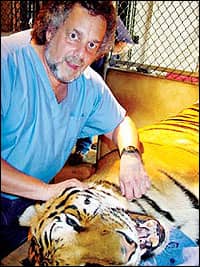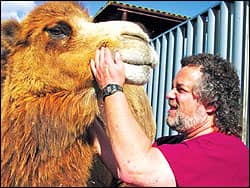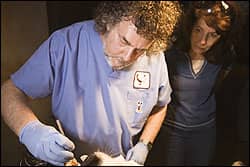by Lori Sichtermann
Edward Shagam, DDS, PA, creates healthy grins for children and other wild animals

Photos by Josh Shagam
Edward Shagam, DDS, PA, is no ordinary orthodontist. When asked to describe his professional experiences, he paints an interesting picture. “It’s very humbling to be in front of a 450-pound tiger. You just don’t put your fingers in its mouth; you put your whole hand in there,” he explains. “And, that certainly goes for an elephant as well.”
For more than 30 years, Shagam has operated a successful private orthodontic practice in Southern New Jersey while having parallel success as a zoological dental consultant. He applies a special blend of professionalism and skill to his patients, regardless of whether they have fingers, paws, claws, or trunks. Shagam specializes in the more challenging aspects of orthodontics, and continuously seeks ways to better the lives of all his patients. His energy and enthusiasm in the realm of orthodontics have made him a pioneer in the field … and the enclosure.
A Grand Entrance
Shagam’s resume is an eclectic read that includes work in television production, business administration and marketing, police K-9 handling (specializing in Search and Recovery), and even road manager for the 1970s rock band Sha Na Na.
Shagam’s entrance into the orthodontic profession, and subsequently the zoo dentistry profession, was characteristically unconventional. He graduated in 1970 from New York’s Albany State University with a Bachelor of Science in business administration and marketing and a minor in television production. He worked in the business arena for a time before he shifted directions and started on the path toward a career in dentistry.
PRACTICE PROFILE
Practice Name: Edward Shagam, DDS, PA
Location: Mt. Holly, NJ; Medford, NJ
Specialty: Orthodontics
External Practice: Zoological Dental Consultant
Years in private practice: 32
Days in private practice per week: 4
Web site: bracez.com
“I love kids, and I especially like working with children with special needs,” Shagam says. “Having a nice smile builds a child’s self-esteem and helps them to keep going. Working with these kids is extremely rewarding, and making them happy with themselves is incredibly important.”
In 1972 Shagam enrolled at Howard University College of Dentistry, Washington, DC. It was there that he became a Doctor of Dental Surgery. He received his orthodontic certificate from Temple University College of Dentistry in Philadelphia and immediately entered private practice.
From the beginning, Shagam’s practice had a charismatic flair that was both enticing and comforting to patients. His approach to the profession is firmly rooted in patient education, with a strong undercurrent of fun. “I like to get everyone involved in the treatment,” Shagam explains. “It’s way too important to downplay and just hope that a child cooperates. We need to educate younger patients on the ‘hows’ and ‘whys’ of what’s going to happen with their orthodontic treatment.”
Shagam makes it a practice to be up front and open in informing patients about their care. His willingness to educate patients extends to his Web site, where a variety of questions can be put to rest, including what to expect at the first visit, what orthodontic appliances will be used, how to brush and floss while wearing braces, and what foods to avoid.
For parents, Shagam offers a separate set of links to put their minds at ease. He provides answers to such questions as when to bring a child into the office for a consultation, whether or not the family dentist can perform orthodontic work, recipes for mouth ulcers, and an answer to the eternal question: “Is there really a tooth fairy?” (Yes.)
Be Our Guest
The effort Shagam puts forth to educate his patients is all part of a larger picture. “It’s important to reduce some of the fear that is associated with orthodontics and to make our patients comfortable,” he says. “I like to build a bond with my patients. An orthodontic practice should be patient-oriented. It shouldn’t be factory-like.”
Shagam wanted to offer his customers more than just a polite handshake and a clean waiting room. Thus, he sought examples of how major corporations handled their customer service, and was consistently impressed by the tactics of Mickey Mouse and pals. To bring some of that magic to his practice, Shagam enrolled at Disney University in Orlando, Fla, where he became a 1997 graduate in professional development.
Disney University no longer exists, but the information he learned there had a lasting impact on Shagam, and he still applies much of it to his practice today. “They taught you everything from problem-solving to customer relations and how that affects the design of the facility. They taught students how to treat people,” Shagam explains. “One of the most important things I learned at Disney University was that we don’t have patients come into our office, we have guests come into the office.”
The Disney University school of thought is visible throughout Shagam’s practice. The office is painted in bright colors—mostly reds and purples—to present a cheerful atmosphere. Benches replace chairs in the waiting and reception area because, according to Disney University, strangers in a room prefer not to sit next to each other. Thus, with benches, there is more space for guests to feel relaxed.
Another Disney University technique applied by the folks at Shagam’s office is his “open hand” policy, which asks employees to meet, greet, and direct patients with a smile and an open hand. “How many times have you asked where the bathroom is and someone points one finger in the opposite direction? That, to us, is accusatory,” Shagam explains. “We prefer to offer guests an open hand. ‘Why don’t you sit here?’ ‘The bathroom is over there, let me walk you there.’ We make all these motions with an open hand.”
Of the pleasantries offered in Shagam’s office, the cleverest plays to the guest’s sense of smell. “I believe in getting all the senses—even smell,” Shagam notes. “Our office is sprayed twice a day with organic citrus orange peels. People walk in and the smell relaxes them tremendously.”
Disney is also synonymous with fun, and in emulating the company’s approach to guest services, Shagam has applied his own flair for fun to the business. In addition to offering in-depth information on the procedures, Shagam’s Web site and offices also give visitors a chance to try their hand at complimentary video games. And, if you call the practice after hours, you’re more than likely going to hear an impression of Arnold Schwarzenegger’s voice informing folks of when the staff “will be back.”
“It’s all about getting to know the customer and being nice to them,” Shagam explains. “It really does work. Have you ever heard of anyone who had a bad time at Disney?”
Where it Counts

“I’m known for taking the most difficult cases,” Shagam says. “I take the ones no one else wants.”
Shagam’s effort to please patients has yielded him a client base that particularly benefits from his approach toward guest services. “I’m known for taking the most difficult cases,” Shagam explains. “I take the ones no one else wants—the cases that are not very easy or will take too much time.”
The types of difficult cases Shagam welcomes range from instances of extreme crowding to impacted eye teeth or impacted molars. He also has become an expert by experience, working with patients who have physical or emotional disabilities. “I do all the procedures by myself so that I can establish a bond with these patients,” Shagam says. “When you’re looking for compliance and cooperation, you have to have that bond with your patients.”
For more than 30 years, Shagam’s approach to orthodontics has enabled him to bond with countless patients. “One of the things I’m most proud of is that I’ve treated three generations of the same family at one time,” he explains. “It’s nice when patients come back to you 10 to 20 years later and give you a hug and say, ‘Thanks. You really made a difference in my life.’ That’s what makes me smile when I go home.”
Lions, Tigers, Bears…and Smiles
In addition to finding success as an orthodontist, Shagam has become a successful zoological dental consultant to numerous zoos across the country. As with his entrance into the orthodontic profession, Shagam came into the zoo dentistry arena by chance.
“I was busy starting my own practice and bumped into a veterinarian who was working at a very large safari park,” he says. “I asked him what they do about dentistry for the animals, knowing that without dentistry you can get into everything from kidney infections to heart problems to infections in the bloodstream. I was told no one had any money to do those types of procedures, so they weren’t being done.”
Having a lifelong love of animals, Shagam took on a handful of exotic animal patients as pro bono cases. It wasn’t long before word of his care circulated throughout the zoological profession, making Shagam highly sought-after. “After all these years working with zoos across the country, animal patients come to me by reputation,” he says. “I’ve worked with some of the same keepers and veterinarians for 30 or more years. It’s been a great experience to work alongside these talented individuals.”
Shagam spent years studying exotic animals—not just the dentistry techniques but also the social behaviors of the animals he works with. This research enables Shagam to put the patient at ease during a procedure, just as he does with humans. “When I’m working with an exotic animal, I have to make sure everyone is comfortable and on the same page,” he says. “When I take a look at an elephant and I have the zookeeper tell the elephant to open wide and stay that way, while the elephant is totally awake, I have to hope that elephant listens to the keeper.”

With some of the larger animals, Shagam has to operate without tranquilizers.

Shagam has worked at the Bronx Zoo, Miami Metro Zoo, and even as an on-call consultant for the Ringling Brothers Circus. He also serves as the dental consultant for the Gorilla Foundation. “I do just about everything,” Shagam says. “When it comes to dentistry, I believe in a lot of community service. And, this is the only way a lot of these animals can get the care that they need. I consider it a form of community service in a different type of community.”
From pumas to polar bears, Shagam has worked with a number of exotic animals, performing oftentimes complicated dental procedures. Thus, it goes without saying that he has some interesting tales to tell for his time spent in the zoological dental arena.
“There have been a number of challenges over the years,” he says. “When it comes to the larger animals, they can’t be tranquilized, so you have to perform procedures on them while they’re awake. I’ve done a partial root canal on an elephant that was awake. That certainly was a challenge.”
Shagam also notes logistical challenges in his experience with zoological dental consulting. “The bears also have been a challenge because they’re so big,” he says. “The keepers can’t bring them inside to be worked on. Thus, we have to go out to their enclosures to do our procedures”
Although these challenges are unique to zoo dentistry, Shagam has come across an even more troublesome hurdle in his work with animals: Funding.
For the past 30 years, Shagam has worked with zoos across the country, providing dental services for animals at no cost to the zoo. “In many instances, the zoos I work for don’t have the resources to pay someone to perform these procedures,” he explains. “If I didn’t come in and do it at my expense, the animal would have to go without the help.”
Because caring for carnivorous choppers isn’t cheap, Shagam has put out a call for sponsorship in an effort to help fund his work with exotic animals. “Doing a root canal on a tiger is incredibly expensive,” he says. “It’s something I love doing, and I’d like to continue helping these animals, but the funding has to be there.”
For more information on how to help, visit Shagam’s Web site at bracez.com.
Supplying care for those in need has been the objective for Shagam since he entered the dental profession. And, as he continues to work with patients both in and out of the zoo, he knows that his style of practice will make a difference. “There are other things in life than just straightening teeth. It’s taking care of what’s behind those teeth—taking care of the whole person or the whole animal in some cases,” he says. “To be able to do that and help both humans and exotic animals is an incredibly satisfying situation to be in.”



Lori Sichtermann is a contributing writer for Orthodontic Products. For more information, contact








